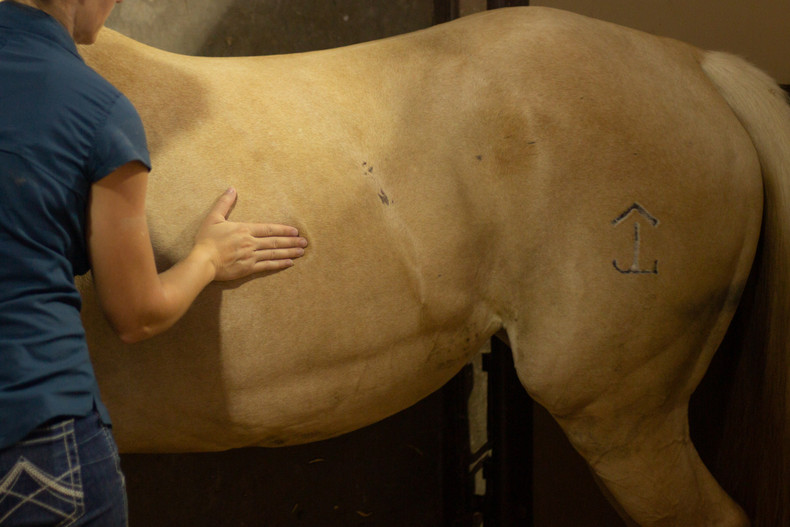A healthy horse allowed free access to graze pasture or eat hay all day has a normal stomach pH of 4 to 7. Researchers found that when food is restricted, it takes only 1 hour for the pH of a horse’s stomach to plummet to 2, meaning it becomes extremely acidic. Hence, the reason to incorporate gastric buffers into the diet of certain horses.
The pH Problem
In a perfect world, our horses would graze pastures or eat hay with continuous access all day every day. They would never be without food and they would never become overweight. But this world is far from perfect. The majority of horses are asked to fit around our work hours or show schedules, which means two meals per day that often have some variation when it comes to the actual hour of meal time.
Some horses suffer from genetic conditions or disease processes that prevent the luxury of 24/7 forage access. Horses with PSSM, Insulin Resistance, or Equine Metabolic Syndrome cannot have full access to green grass, and even some grass hays (especially in northern climates) contain too much sugar to allow free choice hay feeding. Therefore, grazing hours and hay access must be restricted.
A study by the University of Minnesota found horses consume their entire hay meal in less than 3.5 hours. Say you feed at 6:00AM and 6:00PM, the horse will spend 3.5 hours eating, which leaves 8.5 hours of time on an empty stomach. This situation creates a highly acidic environment in the stomach for extended periods of time which predisposes the horse to ulcers, anxiety, and behavioral issues (such as eating dirt, chewing wood, cribbing, weaving, etc).
Solutions for Modern Day Problems
There are two very good solutions to help combat the aforementioned scenario. The first is the use of small hole slow-feeder hay nets. Researchers found that the use of small hole hay nets (those with 1 inch openings) slowed consumption time for the same volume of hay from 3.3 lb per hour to 1.9 lb per hour. This research data can be interpreted and utilized in two ways:
- Scenario 1: If you can only feed a certain amount (i.e. 10 lb) of hay at each feeding, offering it in a small hole hay net will extend your horse’s eating time by 3 hours and lessen the amount of time he spends on an empty stomach by the same amount.
- Scenario 2: If you offer hay free choice (i.e. in a round bale feeder) horses will eat 42% less hay each day which will help you manage calorie intake, control body weight, and lessen the “hay belly” look that can occur with excessive hay consumption.
Bottom line, small hole slow-feeder hay nets are a great way to manage your horse’s forage intake by slowing eating rates and extending the amount of time they spend chewing. Increasing the number of chews a horse makes in a day increases the amount of saliva they produce which acts as the body’s normal natural buffer to stomach acid. Slow feeder hay nets are available in all sizes to fit a single feeding all the way up to an entire large round bale.
The second solution is to feed a gastric buffer supplement designed to neutralize an overly acidic stomach. This is especially helpful for horses that spend periods of time each day on an empty stomach and therefore have less saliva production acting as a natural buffer. Most gastric buffers contain ingredients such as seaweed-derived calcium/lithothamnion, calcium carbonate, sodium bicarbonate, or magnesium oxide. These components work independently of one another and each serve a unique purpose. One buffer alone will not necessarily have the same effect as certain combinations.
Gastric buffer supplements may be fed with the normal grain meal, but they provide heightened benefit when fed just prior to riding, especially if the horse had been without access to food for an hour or more. That time-period is most critical because the stomach will be empty and at a very acidic pH level. Offering a gastric buffer as a snack while you groom and saddle up will neutralize stomach acid, increase saliva production, and reduce the likelihood of acid splashing up onto the non-protected upper portion of the stomach.
The Best Gastric Buffer
Gastro pHix® is a unique supplement that contains a combination of the most effective gastric buffers. Lithothamnion, for example, has been studied for its ability to support healing by reducing gastric ulcer scores an average of 2 grades when fed at 40 grams per day. This research-proven dose of lithothamnion is built into Gastro pHix® along with a series of other research backed technologies to support intestinal epithelial health, tight junctions, healthy mucilage production, and provide fuel to anaerobic bacteria populations within the hind gut.
To learn more about Gastro pHix®, check out these frequently asked questions, read the product specs, watch a webinar or listen to these podcasts:
Need help choosing the right feed or supplement? Get a free nutrition consult.

